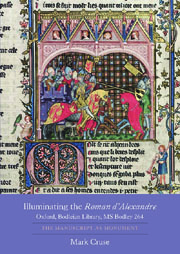 Illuminating the 'Roman d'Alexandre': Oxford, Bodleian Library, MS Bodley 264
Illuminating the 'Roman d'Alexandre': Oxford, Bodleian Library, MS Bodley 264 Book contents
- Frontmatter
- Contents
- List of Illustrations
- Acknowledgements
- Abbreviations
- Introduction
- 1 A Monument to Cortoisie
- 2 Urban Conquest and Spectacle
- 3 “Apraigne d'Alixandre”: Illuminating Exemplarity in Bodley 264
- 4 Alexander, Crusade, and the East in Bodley 264
- 5 The Production, Patronage, and Later Reception of Bodley 264
- Conclusion: Alexander in the Late Middle Ages
- Afterword: Mirror In Pixels
- Bibliography
- Index
- Already Published
5 - The Production, Patronage, and Later Reception of Bodley 264
Published online by Cambridge University Press: 05 February 2013
- Frontmatter
- Contents
- List of Illustrations
- Acknowledgements
- Abbreviations
- Introduction
- 1 A Monument to Cortoisie
- 2 Urban Conquest and Spectacle
- 3 “Apraigne d'Alixandre”: Illuminating Exemplarity in Bodley 264
- 4 Alexander, Crusade, and the East in Bodley 264
- 5 The Production, Patronage, and Later Reception of Bodley 264
- Conclusion: Alexander in the Late Middle Ages
- Afterword: Mirror In Pixels
- Bibliography
- Index
- Already Published
Summary
As the preceding chapters have demonstrated, Bodley 264 is a monument in that it represents a sweeping array of the fundamental values and beliefs of the culture in which it was produced. This final chapter addresses another aspect of this manuscript's monumentality — the ways in which its production drew together different individuals, national and linguistic communities, and generations. Bodley 264 marshalled the efforts of a large group of individuals over many years, and continued to attract the attention and intervention of readers and book artisans generations after it was initially produced. The intense and sustained social energies devoted to Bodley 264 show the ways in which objects may themselves be social actors whose design, creation, and use forge social bonds. Artifacts such as Bodley 264 that participate in the creation of social meaning are never mere instruments, passively perceived and acted upon by human beings, but rather are essential to the establishment of behaviors, relationships, and belief systems. Viewed in this manner, Bodley 264 is not a static or silent manuscript but the enabler of dynamic interaction between different individuals and communities: the authors of the works compiled in it, the manuscript's patron, scribes, illuminators, and those in England who, decades after its original creation, commissioned and executed the expansion of Bodley 264 into the book we know today.
- Type
- Chapter
- Information
- Illuminating the 'Roman d'Alexandre': Oxford, Bodleian Library, MS Bodley 264The Manuscript as Monument, pp. 181 - 198Publisher: Boydell & BrewerPrint publication year: 2011
